Choosing a trusted dental implant lab partner means finding more than a vendor—it’s selecting a reliable extension of your clinical and operational workflow. The strongest partners combine proven experience, technical precision, clear communication, and the capacity to deliver consistently at scale, reducing operational risk and ensuring predictable outcomes.
Key evaluation criteria include:
- Experience and Credentials – Years in business, technician certifications (e.g., CDT), and stable client relationships.
- Quality and Compliance – ISO, FDA, and ADA material standards with robust QC processes and flexibility for custom cases.
- Digital Workflow Integration – Compatibility with CAD/CAM systems, STL formats, and platforms like iTero or 3Shape.
- Communication and Support – Clear update channels, responsive cross-time-zone teams, and technical troubleshooting.
- Turnaround and Delivery – Predictable timelines, on-time delivery, and reliable global logistics.
- Transparent Pricing – Clear cost structures, competitive rates, and total cost of ownership analysis.
- Reputation Verification – Testimonials, repeat order patterns, facility inspections, and reference checks.
By assessing these factors against measurable standards, procurement teams can form partnerships that endure, scale, and deliver tangible results over time.
Key factors that define a trusted dental implant lab partner
A trusted dental implant lab partner consistently delivers high-quality restorations, meets timelines, and operates with transparent standards. The most dependable labs demonstrate these qualities through measurable benchmarks, proven longevity, and professional certifications. Understanding these factors helps procurement teams identify partners who can perform reliably over the long term.
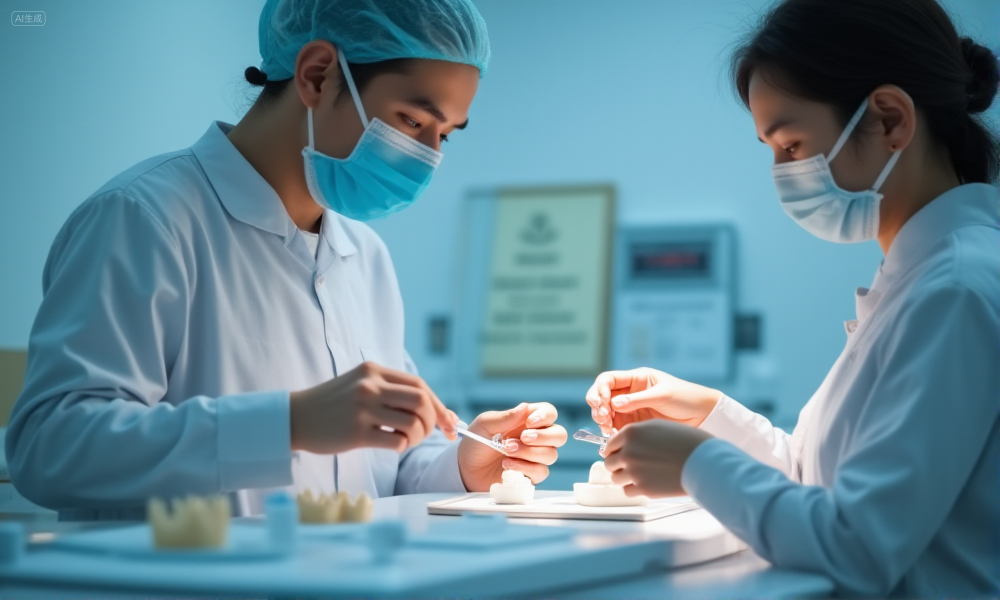
Trusted-implant-lab-benchmarks
Industry-recognized benchmarks for trust and reliability
- ISO 13485 compliance – Confirms the lab follows a recognized medical device quality management system.
- FDA/ADA-approved materials – Ensures restorations meet safety and biocompatibility standards.
- On-time delivery rate above 95% – Demonstrates logistical reliability for consistent case planning.
A procurement team in Brisbane once struggled with delayed deliveries and missing FDA documentation from a previous supplier. Switching to an overseas dental lab with ISO 13485 compliance and documented delivery metrics reduced their approval time from three weeks to just five days—directly impacting patient scheduling efficiency.
How years in business reflect proven expertise
Experience often translates into more refined workflows and a deeper understanding of clinical nuances. A lab with over a decade in the implant field has likely navigated changes in CAD/CAM technology, material innovations, and international shipping requirements. This maturity helps avoid common pitfalls, such as design errors or customs delays, that less experienced labs may encounter.
Certifications that indicate technician skill and lab credibility
- CDT certification – Shows individual technicians meet rigorous skill and knowledge standards.
- Association memberships – Affiliation with national or international dental organizations adds an extra layer of credibility.
- Third-party lab audits – Independent evaluations confirm adherence to quality and safety protocols.
In practice, the strongest partnerships are built on a mix of measurable compliance, proven experience, and verified skill. Labs that can consistently show these credentials not only meet expectations—they earn lasting trust.
Choosing a trusted lab partner is one piece of the puzzle. For a complete view on how to evaluate outsourcing options for dental implant production, see our full decision framework.
How to evaluate implant quality, materials, and compliance standards
Evaluating an implant lab’s quality, materials, and compliance standards is critical to ensuring predictable clinical outcomes and avoiding costly remakes. Reliable labs maintain robust quality control systems, source certified materials, and balance consistent manufacturing with case-specific customization.
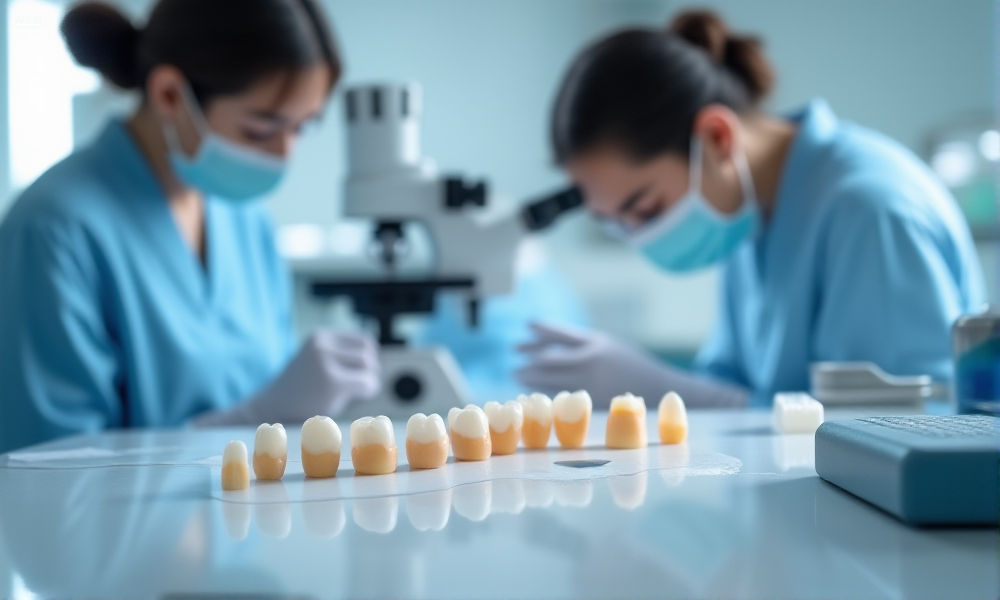
Implant-lab-quality-control-standards
Quality control processes every lab should have
- Incoming material inspection – All metals, ceramics, and polymers are checked against supplier specs before use.
- In-process checks – Margin fit, occlusion, and shade accuracy verified at multiple production stages.
- Final inspection and documentation – Restorations are measured against the digital design file, with photos stored for record-keeping.
One European distributor we work with reduced remake rates by 30% after adopting our staged QC process, particularly the in-process checks, which caught margin discrepancies before final sintering.
ADA-, FDA-, and ISO-certified materials for implant restorations
- ISO 13485 – Confirms the lab operates under an internationally recognized medical device quality system.
- FDA-registered materials – Ensures all implant components meet US safety and biocompatibility requirements.
- ADA Seal of Acceptance – Signals adherence to professional standards in dental materials.
When an Australian clinic switched to ADA- and FDA-compliant zirconia from our overseas dental lab, they passed a hospital procurement audit without any additional material testing, cutting case onboarding time from weeks to days.
Balancing consistency and customization for patient-specific needs
While standardized workflows ensure predictable outcomes, every implant case has unique variables such as tissue profile, bite dynamics, and aesthetic requirements. A strong lab adapts its design and milling parameters without sacrificing quality benchmarks. This balance ensures the final restoration fits the patient perfectly while maintaining the durability and safety standards required for long-term success.
In summary, the best implant labs combine meticulous QC processes, certified materials, and adaptive manufacturing. This combination not only meets regulatory demands but also delivers consistent, high-quality outcomes in diverse clinical scenarios.
What role does digital workflow integration play in collaboration success?
Digital workflow integration directly impacts the speed, accuracy, and overall success of collaboration between dental practices and their implant lab partners. When file compatibility, case submission, and margin accuracy are optimized, both turnaround time and remake rates improve significantly.
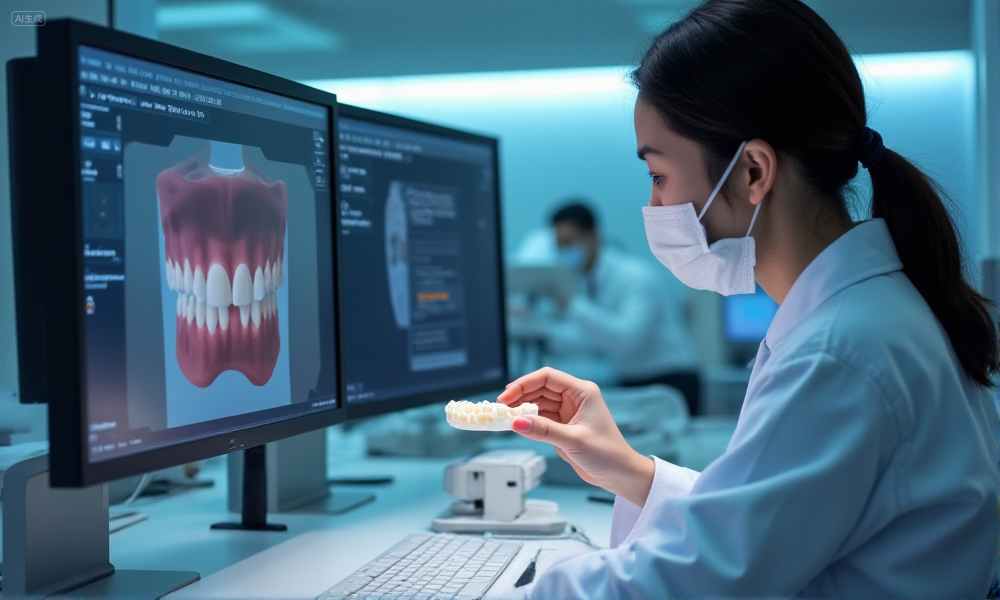
Digital-workflow-integration-implant-lab
File compatibility and CAD/CAM readiness (STL, iTero, 3Shape)
- Universal STL support – Ensures files can be read and processed without conversion delays.
- Native iTero and 3Shape integration – Minimizes data loss when transferring scans.
- Version control and naming protocols – Prevents mix-ups in multi-case workflows.
A UK-based clinic reduced initial processing time by 40% after switching to a lab with direct iTero integration and automated file naming, eliminating manual data conversion.
Reducing turnaround time through seamless digital case submission
A streamlined submission process—where scans, design notes, and shade information are sent in one package—eliminates gaps that cause delays. With cloud-based portals and direct CAD/CAM queueing, cases move from design to milling without waiting for email confirmation. In our experience as an overseas dental lab, these systems can cut production lead time by up to two days, a critical factor for clinics managing multiple implant cases per week.
Avoiding remakes with accurate margin design and scan data
- Margin marking tools – Highlight critical design areas during the digital design phase.
- Real-time scan verification – Flags incomplete or distorted scan data before milling.
- Cross-checking occlusion and contact points – Prevents costly remakes from poor articulation data.
One North American DSO avoided a batch remake of 12 crowns by using a lab that verified scan integrity before manufacturing, catching two incomplete margins that would have failed fit tests.
In short, digital workflow integration is not just a convenience—it’s a collaboration multiplier. The right tools and protocols enable smoother operations, faster deliveries, and higher first-time fit rates.
How to assess communication, support, and collaboration efficiency
Strong communication and support are as critical as technical quality when working with an implant lab. The best partnerships are built on open channels, reliable technical assistance, and the ability to coordinate seamlessly across time zones.
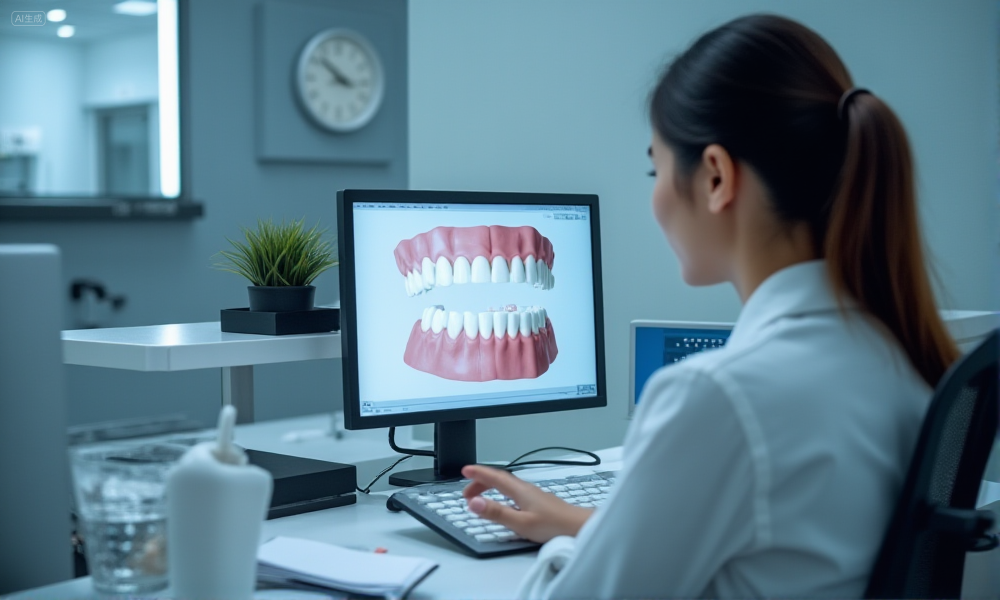
Implant-lab-communication-support
Open and responsive communication channels for case updates
- Multiple contact methods – Email, messaging apps, and portal-based updates.
- Clear response time policies – Commitment to reply within agreed timeframes.
- Proactive status updates – Automated or manual progress reports to keep cases moving.
One Canadian clinic praised our overseas dental lab for sending mid-production updates with photos, allowing them to approve shade adjustments before final glazing.
Dedicated technical support to resolve case-specific challenges
Case-specific issues—like unexpected scan artifacts or unusual margin profiles—require direct access to experienced technicians. A lab with dedicated technical support can troubleshoot in real time, avoiding production delays. In one instance, a Middle Eastern distributor’s scan file had a missing distal contact; our CAD team spotted and corrected it within hours, keeping the delivery date on track.
Coordinating effectively across time zones for global projects
- Shift overlap scheduling – Ensures real-time interaction between lab and clinic teams.
- Shared project calendars – Keeps all stakeholders aligned on milestones.
- Local holiday awareness – Prevents disruptions during critical deadlines.
A US-based DSO noted a 15% faster case turnaround after implementing a time zone overlap plan with their implant lab, enabling direct communication during design approvals.
Ultimately, effective communication and coordination ensure technical precision is matched by operational smoothness. This synergy is what turns a capable lab into a truly dependable partner.
How to assess turnaround time and delivery reliability
Turnaround time and delivery reliability directly affect treatment planning and patient satisfaction. A dependable implant lab delivers within promised timelines, balances speed with precision, and manages logistics to avoid delays.
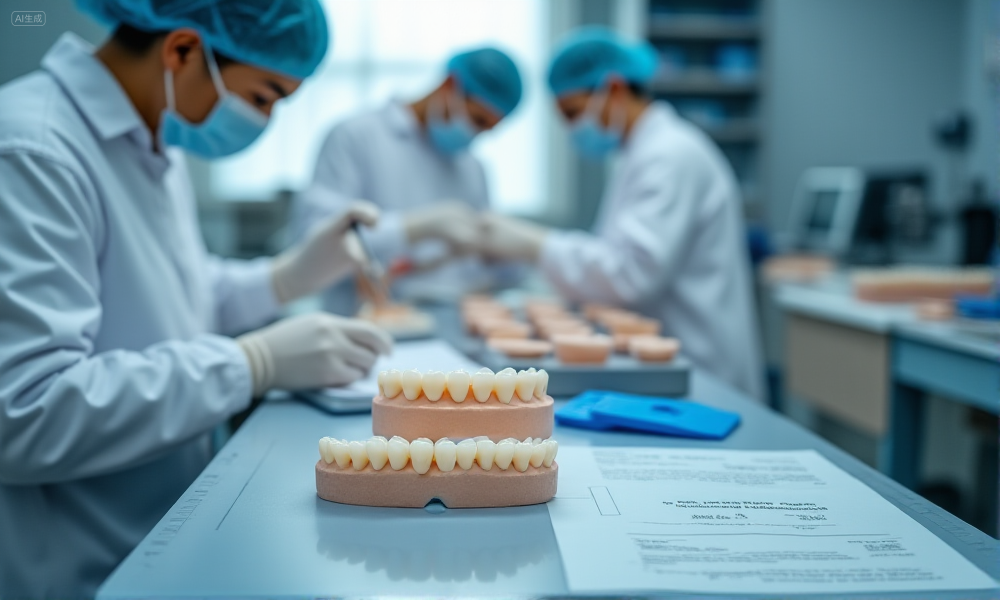
Implant-lab-turnaround-delivery
Typical production timelines for implant crowns and bridges
- Single-unit crowns – Typically 5–7 lab working days from scan to dispatch.
- Multi-unit bridges – Often 7–10 lab working days depending on complexity.
- Full-arch restorations – Can require 12–15 lab working days for precise fit and esthetics.
One Scandinavian clinic reduced chairside delays by aligning treatment plans with our overseas dental lab’s production calendar, ensuring each phase had predictable delivery dates.
Balancing speed with quality to avoid costly remakes
While shorter production times are attractive, rushing can compromise fit, shade, or strength. A lab with a balanced approach will meet timelines without sacrificing critical quality checks, such as occlusion verification or ceramic layering inspections. In our experience, the best results come from labs that adjust scheduling based on case complexity rather than applying a one-size-fits-all lead time.
Logistics coordination and customs handling for overseas shipments
- Partnering with reliable global shipping carriers – Ensures consistent transit times.
- Pre-clearing customs paperwork – Reduces hold times at borders.
- Tracking and communication – Keeps clients informed of shipment status in real time.
A Middle Eastern distributor avoided a week-long delay during a holiday period because our logistics team pre-cleared all implant abutments with customs, allowing for uninterrupted delivery.
Ultimately, the most reliable implant lab partners set clear expectations, adapt schedules to case demands, and manage the delivery chain end-to-end. This ensures cases arrive on time, every time.
What cost structures indicate a sustainable partnership
A sustainable partnership with an implant lab requires more than a low unit price—it depends on pricing models that support consistent quality, predictable expenses, and mutual growth over time.
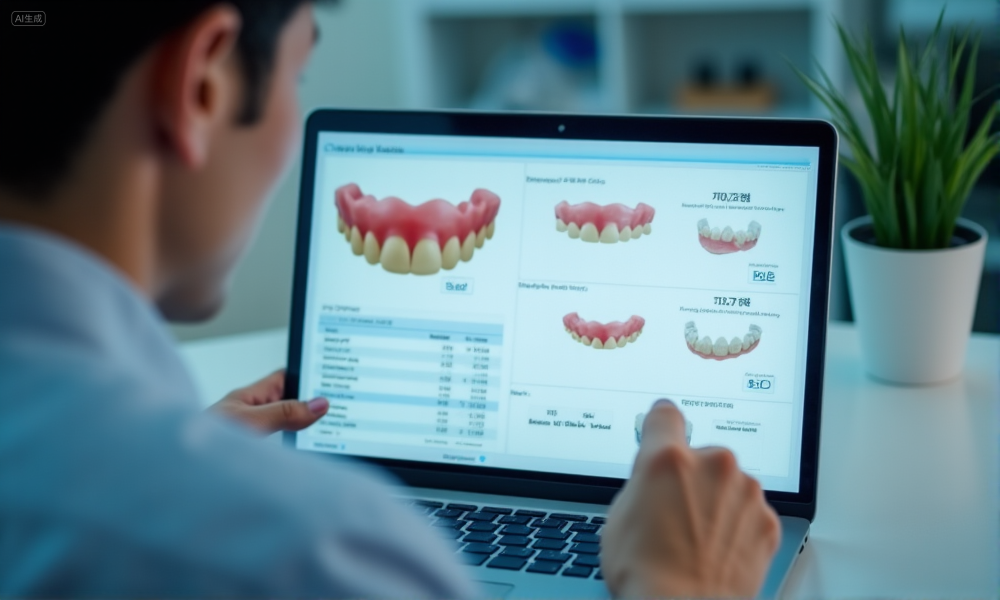
Implant-lab-cost-structures
Understanding wholesale vs. per-unit pricing in implant cases
- Wholesale pricing – Suitable for high-volume orders, offering lower per-unit cost and simplified billing.
- Per-unit pricing – Ideal for smaller, varied orders where flexibility is key.
- Hybrid models – Combine wholesale benefits for standard cases with per-unit pricing for custom work.
One European distributor reduced procurement complexity by shifting to a hybrid model with our overseas dental lab, which allowed them to standardize 80% of cases while keeping flexibility for unique implants.
Evaluating total cost of ownership (TCO) beyond the unit price
Unit price alone can be misleading if it leads to higher costs elsewhere. Factoring in total cost of ownership means considering remake rates, shipping fees, customs duties, and communication efficiency. For example, a slightly higher unit price from a lab with near-zero remake rates can lower overall spend by reducing chairside adjustments and re-fabrications.
How transparent pricing reduces procurement risk
- Itemized quotes – Show exactly what is included in the price.
- No hidden fees – Avoids surprise charges for rush orders or special materials.
- Clear revision policies – Ensures clients know what adjustments are covered.
A US-based DSO avoided budget overruns when their lab partner introduced fully itemized quotes, making it easier to forecast annual spend and allocate resources accordingly.
In practice, sustainable pricing structures balance cost efficiency with long-term reliability. Clear terms and predictable expenses give procurement teams the confidence to invest in lasting partnerships.
How to verify a lab’s track record and reputation
Verifying a lab’s performance history ensures you are partnering with a facility that consistently meets expectations. The process should include reviewing documented proof, monitoring client retention, and conducting direct inspections.
Implant-lab-track-record-verification
Reading case studies and client testimonials for real-world proof
- Published case studies – Demonstrate technical capability and problem-solving approaches.
- Client testimonials – Provide firsthand accounts of service quality.
- Independent reviews – Add credibility beyond the lab’s own marketing.
A Canadian practice selected our overseas dental lab after reading a detailed case study showing how we resolved a complex implant bridge fit issue within the original delivery window.
Checking repeat order patterns and long-term client retention
Long-term retention is one of the strongest indicators of a lab’s reliability. Consistent reorders from the same client suggest stable quality, predictable delivery, and good communication. For example, one European distributor has worked with us for over seven years, steadily increasing order volumes—a sign that our processes align well with their operational needs.
Using facility inspections and reference checks to confirm credibility
- On-site visits – Allow direct observation of production quality and workflow.
- Video tours – Useful when in-person visits are impractical.
- Reference checks – Speaking with current clients provides unfiltered feedback.
A Middle Eastern distributor confirmed our lab’s credibility through both an on-site inspection and direct reference calls, ensuring our capabilities matched the commitments outlined in proposals.
The most reliable verification combines documented evidence, client history, and direct observation—providing a complete picture of a lab’s capacity to deliver on its promises.
Conclusion
Choosing the right implant lab partner is a strategic decision that affects clinical outcomes, operational efficiency, and long-term business stability. By applying clear evaluation criteria—from quality systems and material compliance to communication, delivery, and pricing—procurement teams can identify partners who consistently perform. As an overseas dental lab with experience in global collaborations, we have seen how transparency, technical expertise, and reliable logistics turn a vendor into a trusted partner. The strongest relationships are built on measurable performance and mutual trust, ensuring both sides grow together in a competitive market.


